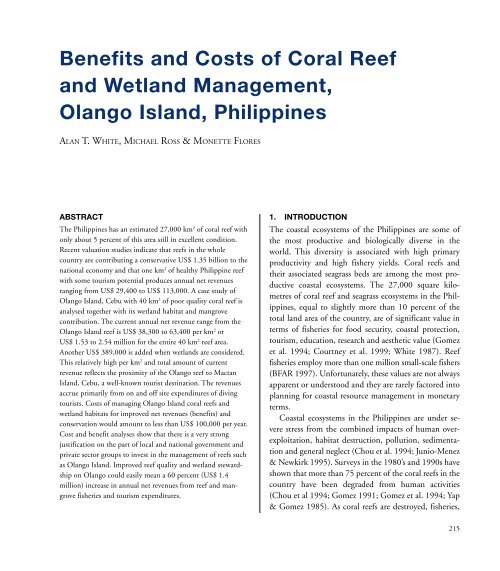You also want an ePaper? Increase the reach of your titles
YUMPU automatically turns print PDFs into web optimized ePapers that Google loves.
Benefits and Costs <strong>of</strong> <strong>Coral</strong> Reef<br />
and Wetland Management,<br />
Olango Island, Philippines<br />
ALAN T. WHITE, MICHAEL ROSS & MONETTE FLORES<br />
ABSTRACT<br />
The Philippines has an estimated 27,000 km 2 <strong>of</strong> coral reef with<br />
only about 5 percent <strong>of</strong> this area still in excellent condition.<br />
Recent valuation studies indicate that reefs in the whole<br />
country are contributing a conservative US$ 1.35 billion to the<br />
national economy and that one km 2 <strong>of</strong> healthy Philippine reef<br />
with some tourism potential produces annual net revenues<br />
ranging from US$ 29,400 to US$ 113,000. A case study <strong>of</strong><br />
Olango Island, Cebu with 40 km 2 <strong>of</strong> poor quality coral reef is<br />
analysed together with its wetland habitat and mangrove<br />
contribution. The current annual net revenue range from the<br />
Olango Island reef is US$ 38,300 to 63,400 per km 2 or<br />
US$ 1.53 to 2.54 million for the entire 40 km 2 reef area.<br />
Another US$ 389,000 is added when wetlands are considered.<br />
This relatively high per km 2 and total amount <strong>of</strong> current<br />
revenue reflects the proximity <strong>of</strong> the Olango reef to Mactan<br />
Island, Cebu, a well-known tourist destination. The revenues<br />
accrue primarily from on and <strong>of</strong>f site expenditures <strong>of</strong> diving<br />
tourists. Costs <strong>of</strong> managing Olango Island coral reefs and<br />
wetland habitats for improved net revenues (benefits) and<br />
conservation would amount to less than US$ 100,000 per year.<br />
Cost and benefit analyses show that there is a very strong<br />
justification on the part <strong>of</strong> local and national government and<br />
private sector groups to invest in the management <strong>of</strong> reefs such<br />
as Olango Island. Improved reef quality and wetland stewardship<br />
on Olango could easily mean a 60 percent (US$ 1.4<br />
million) increase in annual net revenues from reef and mangrove<br />
fisheries and tourism expenditures.<br />
1. INTRODUCTION<br />
The coastal ecosystems <strong>of</strong> the Philippines are some <strong>of</strong><br />
the most productive and biologically diverse in the<br />
world. This diversity is associated with high primary<br />
productivity and high fishery yields. <strong>Coral</strong> reefs and<br />
their associated seagrass beds are among the most productive<br />
coastal ecosystems. The 27,000 square kilometres<br />
<strong>of</strong> coral reef and seagrass ecosystems in the Philippines,<br />
equal to slightly more than 10 percent <strong>of</strong> the<br />
total land area <strong>of</strong> the country, are <strong>of</strong> significant value in<br />
terms <strong>of</strong> fisheries for food security, coastal protection,<br />
tourism, education, research and aesthetic value (Gomez<br />
et al. 1994; Courtney et al. 1999; White 1987). Reef<br />
fisheries employ more than one million small-scale fishers<br />
(BFAR 1997). Unfortunately, these values are not always<br />
apparent or understood and they are rarely factored into<br />
planning for coastal resource management in monetary<br />
terms.<br />
Coastal ecosystems in the Philippines are under severe<br />
stress from the combined impacts <strong>of</strong> human overexploitation,<br />
habitat destruction, pollution, sedimentation<br />
and general neglect (Chou et al. 1994; Junio-Menez<br />
& Newkirk 1995). Surveys in the 1980’s and 1990s have<br />
shown that more than 75 percent <strong>of</strong> the coral reefs in the<br />
country have been degraded from human activities<br />
(Chou et al 1994; Gomez 1991; Gomez et al. 1994; Yap<br />
& Gomez 1985). As coral reefs are destroyed, fisheries,<br />
215


















